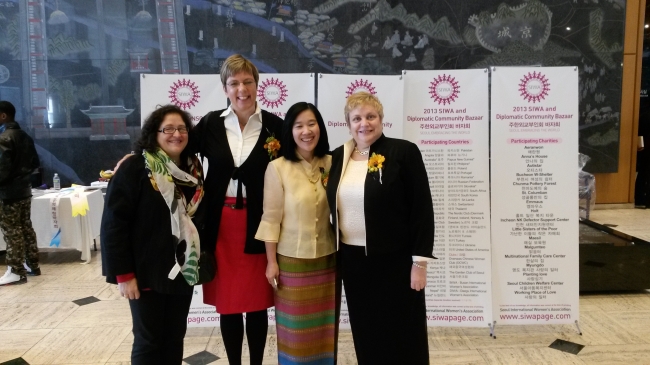 |
Seoul International Women’s Association President Terri Hartman (right) poses with other SIWA members during the association’s bazaar at the entrance of the Seoul Museum of History in downtown Seoul on Tuesday. From left: Pilar Perez-McKay, SIWA public relations official; Ingrid Peeters, chairwoman of SIWA’s Bazaar Committee; Nuchjaree Klongsungsorn, wife of Thai Ambassador to South Korea Kittiphong na Ranong; and Hartman.(Philip Iglauer/The Korea Herald) |
From the look of the crowds at the Seoul Museum of History on Tuesday, the Bazaar 2013 could be the largest yet for Korea’s largest expatriate women’s association, but it was also the last for Seoul International Women’s Association president Terri Hartman.
When Hartman steps down from her post in May, she will have left an indelible mark on not just SIWA, but also the expatriate and diplomatic community. She will have served three one-year terms as the association’s president, the maximum number according its by-laws.
Perhaps the largest change for the group is physical: The venue for the annual diplomatic and community bazaar. Now in its 35th year, this year marks the second time the signature event has taken place at the Seoul Museum of History, centrally located near Gwanghwamun Station in downtown Seoul.
“Last year was the first time to hold the bazaar here, and it was a learning experience for the both of us. With experience from last year, the museum was a little more creative in accommodating us,” said Hartman amid the throngs of shoppers at an out of the way table on the second floor of the museum.
This year, 38 diplomatic missions manned booths selling everything from kitschy cultural items to high-end designer labels. An additional 12 embassies donated items, too.
The organization has changed in other ways as well. SIWA saw an expansion in the number of committees and groups that make up the heart of what the association does.
Hartman ticked off a number of new, active groups for members to participate in, such as the SIWA Book Club, a working women’s network, and a cultural exchange committee, in which once every three months someone delivers a presentation about their country.
“It is not me who has changed SIWA; it is all the women who have changed SIWA,” she demurred, adding the Bazaar would not be possible without an active welfare committee, researching potential charities for SIWA to support.
The ladies on the welfare committee traveled all over the country on their own time and budget, looking for worthy charities and even going as far as Jeju Island this year, Hartman said. “Luckily we are so fortunate that we have so many talented women on our board.”
SIWA raised 128 million won for charity last year, with more than 8,000 people visiting the bazaar. Since the association’s first charity market in 1970, the annual event has raised more than 2 billion won, according to the bazaar program.
By Philip Iglauer (
ephilip2011@heraldcorp.com)






![[Herald Interview] 'Trump will use tariffs as first line of defense for American manufacturing'](http://res.heraldm.com/phpwas/restmb_idxmake.php?idx=644&simg=/content/image/2024/11/26/20241126050017_0.jpg)
![[Health and care] Getting cancer young: Why cancer isn’t just an older person’s battle](http://res.heraldm.com/phpwas/restmb_idxmake.php?idx=644&simg=/content/image/2024/11/26/20241126050043_0.jpg)
